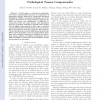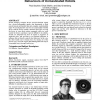48 search results - page 3 / 10 » Evolving Motion of Robots with Muscles |
ICRA
2009
IEEE
14 years 4 months ago
2009
IEEE
— Human hands are capable of many dexterous grasping and manipulation tasks. To understand human levels of dexterity and to achieve it with robotic hands, we constructed an anato...
IROS
2007
IEEE
14 years 4 months ago
2007
IEEE
— Human walking emerges from synergy of whole body dynamics: not only legs, but also a torso, arms, and a head are compliantly connected with each other by antagonistic muscles. ...
IROS
2009
IEEE
14 years 4 months ago
2009
IEEE
Abstract— In this paper, a strategy for pathological tremor compensation based on co-contraction of antagonist muscles induced by Functional Electrical Stimulation (FES) is prese...
ICRA
2007
IEEE
14 years 4 months ago
2007
IEEE
Eye motion strategies in animals and humans have v e2 h2 the goal of optimizing visual perception, therefore, the study of eye motions plays an important role in the design of huma...
HRI
2009
ACM
14 years 4 months ago
2009
ACM
Several emerging computer devices read bio-electrical signals (e.g., electro-corticographic signals, skin biopotential or facial muscle tension) and translate them into computer- ...


